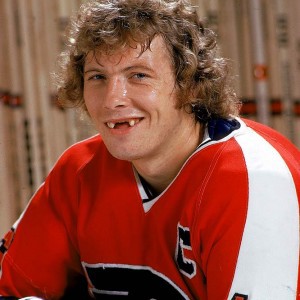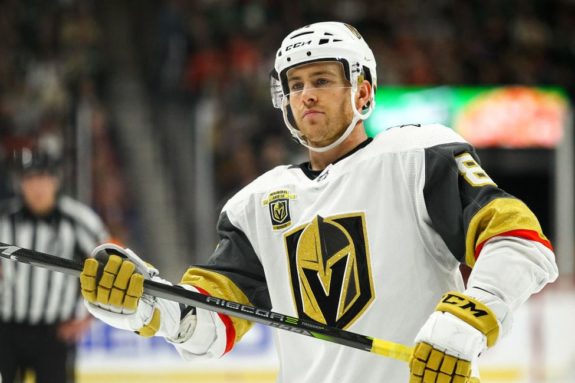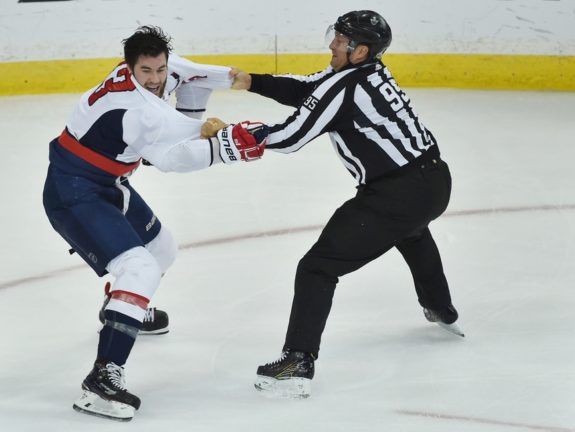It did not take long for this year’s Stanley Cup Final to generate drama beyond the confines of the ice. In Game 1 between the Washington Capitals and the Vegas Golden Knights, a bone-crushing blindside hit was delivered that spawned conversations across the NHL. Golden Knights forward Jonathan Marchessault was the recipient of the hit delivered by Tom Wilson of the Capitals.
The Hit by Wilson
The hit happened shortly after Wilson scored the tying goal at the 1:10 mark of the third period. It was a bizarre goal as the puck took a detour by way of Marc-Andre Fleury’s skate. It put the Capitals up 4-3 and constituted the fourth lead change of the contest.
Approximately four minutes later, Wilson decided it was time to wreak a little havoc. He laser-focused on Marchessault and plastered him shoulder to shoulder after Marchessault no longer had the puck. He went down immediately and was eventually led to the dressing room. Wilson received a minor penalty for interference.
Fortunately, Marchessault was able to return to the ice and suffered no visible injuries from the blindside blast. Marchessault had to go through the NHL’s concussion protocol, including a few minutes in the “quiet room”. The whole incident gives rise to the question, “What should the league’s protocol be on these types of blindside hits?”
Has the issue of late, blindside hits spent too much time in the quiet room?
Argument One: “It Was a Legal Hit”
Among the plethora of hockey minds and fans that have talked about the hit since Game 1, there is a contingent of mostly “old school” fans who argue that the hit was legal and are wondering what all the fuss is about. Technically speaking, it was a legal hit, shoulder to shoulder. He did not aim for his head or spear him or do anything that looked like he was trying to break the existing rules of the game.

Sports talk phone lines were lit up by callers defending the hit as legal. Part of the rationale was that he did not hit him in the head or “Back in the day, that type of hit was routine in the NHL.” A good example of “back in the day” is the famous Philadelphia Flyers teams known as the Broad Street Bullies. The Bullies consisted of Bobby Clarke, their coach Fred ‘The Fog’ Shero and tough guys Dave ‘The Hammer’ Schultz, Andre ‘Moose’ Dupont, Don Saleski and Bob ‘Hound Dog’ Kelly.
Interestingly the Bullies won two Stanley Cups in 1973-74 and 1974-75. In November 2014, Adam Proteau wrote about the Bullies in The Hockey News, stating that the Flyers’ first Cup win was against the heralded Boston Bruins with the incomparable Bobby Orr and Phil Esposito.
Proteau recounted this story from Bob Kelly: “Fred [coach Shero] came in to tell us the game plan and he said, ‘I think the game plan is going to be we’re going to give Orr the puck.’ We said, ‘Why the hell would you give Bobby Orr the puck? That’s the last thing you want to do.’ But it worked out. He just said, ‘I want you to work him, pressure him. By no means spear him or hurt him, but just bump him, make him skate around you, tire him out. As the series wears on, it’s going to be tough on him.’ And Freddy was right.”
This is a key point about the Bullies. They had a well-deserved reputation for fighting and playing tough. Michael Langlois recalls Game 6 of the 1974 Stanley Cup Final: “I think Clarke goaded Orr into more of a ‘fight’ than Orr should have been getting into late in the game. To see these hockey warriors fighting – for the puck, for ice and then each other – was something to see. As valuable as Clarke was, getting Orr off the ice late in the game was a trade-off you’d take every time.”
But, there was an undeniable respect for Orr. The Bullies made no apology for their bare-knuckles brand of the game. But, even a group of “tough guys” had enough respect for a legend like Orr not hurt him with dirty hits. They don’t often get the credit for being excellent hockey players — that fact is shrouded in the legend of their brawling, enforcing nature.
There are still fans who miss the Scott Stevens style of hockey, some even missing the fighting at the drop of a hat style of the Bullies. But, the NHL has moved beyond that part of the game, and what is left are some grey areas, like blindside hits that don’t aim for the head. Hits like the one Wilson laid on Marchessault. Will the league take a look at this type of play in the offseason or, as Kerry Fraser Tweeted, have they already looked at it? If so, why no discipline for Wilson?
The 5 + game misconduct for Interference was instituted for the very type of late blindside hit Tom Wilson just delivered.
— Kerry Fraser (@kfraserthecall) May 29, 2018
The League May Be Blind(sided)
The NHL seems to agree with those old school fans on this issue. The league has taken up many issues regarding player safety, even if some might argue that they lag leagues like the NFL in its concerns about concussions and Chronic Traumatic Encephalopathy (CTE). One can say however that they are not “champing at the bit’ to deal with the issue.
For example, in a lengthy but thorough examination of the CTE issue and the NHL, Adam Kilgore wrote last week in the Washington Post a column that included this quote that NHL commissioner Gary Bettman gave to reporters in March, after an NFL official acknowledged the link between football and CTE:
It’s fairly clear that playing hockey isn’t the same as football. And as we’ve said all along, we’re not going to get into a public debate on this.
But, with hits like Wilson’s occurring on the league’s biggest stage – the Stanley Cup Final – a public debate may be unavoidable in spite of Bettman’s desire to keep it out of the public square.
According to USA Today, Marchessault had this to say about Wilson’s hit:
I saw the hit. I remember everything. It’s a late hit. I think the league’s going to take care of it. We know what type of player he is out there. You’ve got to keep your head up when he’s there.
Many people on the morning sports talk shows and on social media felt confident that Marchessault was right, expecting the league to announce discipline for Wilson.

By mid-day on Tuesday, however, the NHL’s Department of Player safety ruled in an unexpected manner:
“The Department of Player Safety told ESPN that there were a few factors that kept the Wilson hit from rising to the level of suspension. First, the hit was shoulder to shoulder rather than a hit to the head. The hit also was within the flow of the game, rather than the kind of retaliatory hits that have warranted suspensions in the past — such as the four-game ban earned by Bobby Farnham of the Devils for a hit on St. Louis Blues forward Dmitrij Jaskin in January 2016. The NHL didn’t dispute that the hit was late but determined it wasn’t as egregiously late as other interference plays that rose to the level of suspension.”
Wilson Pot, Meet Kettle
And just like that, the NHL gave the green light to players like Wilson to blast away at the unsuspecting, the unprepared, and the unaware. A solid check to the body is designed to separate a player from the puck. In this play, Marchessault had been rid of the puck for a couple of seconds so Wilson’s hit was not meant to separate him from the puck. As previously mentioned, the NHL has addressed the issue of blindside hits, but may it seems that they may need some encouragement to stay true to its own rules.
The 5 + game misconduct for Interference was instituted for the very type of late blindside hit Tom Wilson just delivered.
— Kerry Fraser (@kfraserthecall) May 29, 2018
Ironically, The Hockey Writers’ Sammi Silber pointed out in her May 17 article, Capitals’ Wilson Displeased with Stralman Hit, that Wilson was not happy to be on the receiving end of a blindside hit delivered by Anton Stralman of the Tampa Bay Lightning: “It’s a vulnerable position, and you know, there’s no doubt there’s contact with my head,” Wilson said. “I’m not here to complain about anything. I’m just talking about it for the better of the game and for the better of player safety.”
Silber pointed out that Stralman seemed to shift at the last minute and direct the hit to Wilson’s shoulder. Nevertheless, Wilson was not happy. The player who has a deserved reputation for dishing out similar hits — as evidenced in his Game 1 blast of Marchessault — didn’t like being hit himself. Imagine that.

The league is now in a situation where it will likely have to address these types of hits. Not because it wants to, as Bettman articulated, but because the CTE issue is not going to go away. In his Washington Post piece, Kilgore notes:
“More than 100 retired players have brought a class-action lawsuit against the NHL over brain injuries suffered while playing…Those in the suit seek medical care and a monitoring regime for the roughly 4,300 living retired players. They claim they entered into the league with a clear understanding of the harm the game could cause their bodies but not of the life-changing effects of brain trauma they suffered. They allege NHL teams provided inadequate oversight and care to treat brain injuries, all while the league promoted the game’s violence, including bare-knuckle bouts on the ice.”
No, commissioner, this is not going to go away, even though Marchessault was not hit in the head directly. But, he was blasted without any opportunity to defend himself, and he could have sustained a concussion from such a hit. The NHL may pretend to be blind to the blindsiding issue – cloaking the matter in technical jargon that speaks to whether or not a player’s head was hit – but it will not be able to keep up that pretence for much longer.
As with the legacy of Stevens, some will end up calling Wilson a dirty player while others will call him tough. Silber quoted Wilson again: “When someone gets run from behind, the next couple shifts you’re going to be more tentative. There’s going to be heavy hits in games. We need to control our emotions and make sure we’re the better team for the majority of the 60.” The irony is so thick you can cut it with a knife.